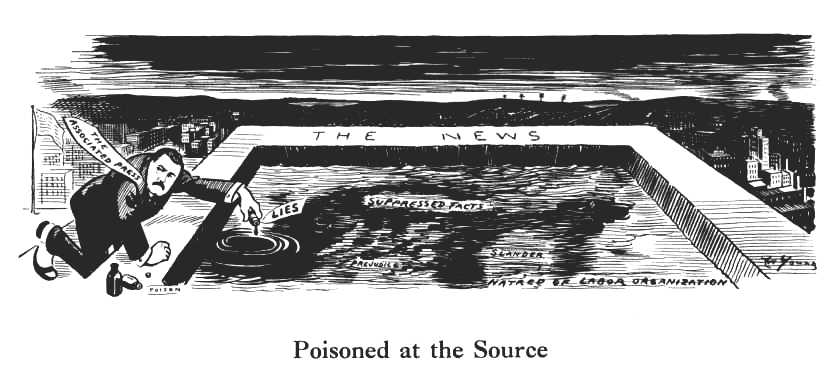Four Methods of Flush Riveting - 1942
It is difficult to imagine Walt Disney making an industrial training video today. During WWII Walt Disney through all the capabilities of the studio behind the war effort. In 1942 Walt Disney made this film for Lockheed & the National Film Board of Canada.
Wednesday, May 30, 2012
Columbia College Library
Art Young 1915
Depiction of the masses being kicked out of the Columbia College Library. The books are shown as neglected.
Art Young April 1915
Depiction of the masses being kicked out of the Columbia College Library. The books are shown as neglected.
Art Young April 1915
Tuesday, May 29, 2012
Food Will Win the War
1942
A propaganda piece in conjunction with the US department of Agriculture and Walt Disney. It is produced with the high quality that we expect from Disney. It is a feel good piece for the US farmer and stresses the importance of high American agricultural output.
The segment where the moon is made of cheese is awesome.
Labels:
1942,
Agriculture,
Disney,
Farmer,
propaganda,
WWII
Wednesday, May 23, 2012
Whistler's Mother - Jim Beaman
Tuesday, May 22, 2012
Shel Silverstein, Tune Thief - 1956
But it's not as if we were stealing the song, Charlie. We just borrow
the tune and add our own original lyrics. Now in the first line,
instead of 'O say can you see,' we put...
I wonder what Shell Silverstine would say about today recording industry?
Friday, May 18, 2012
Man with the Golden Gun
illustrations to Ian Fleming's Man with the Golden Gun April 1965. Latter to be come a James Bond Movie
Thursday, May 17, 2012
The Law Makers - Jacob Burck
Jacob Burck 1933
Depicts JP Morgan making paper dolls out of Congress. The same actors are in play 80 years latter.
Depicts JP Morgan making paper dolls out of Congress. The same actors are in play 80 years latter.
Labels:
1933,
Congress,
J.P. Morgan,
Jacob Burck,
law,
money,
politics
Tuesday, May 15, 2012
A Strong Calm
July 15 1908
Passange (on a stranded steamer, as a life boat apraocahes) "Hi! Save me first, I am a regular sucriber to your funs.
Self centered altruism some things never change.
Passange (on a stranded steamer, as a life boat apraocahes) "Hi! Save me first, I am a regular sucriber to your funs.
Self centered altruism some things never change.
Monday, May 14, 2012
Poisoned at the Source Art Young
Art Young 1912
Poisoned at the Source. Ink and Paper depicting a corruption of the associated press spreading lies and slander. By Art Young 1912-1918
Poisoned at the Source. Ink and Paper depicting a corruption of the associated press spreading lies and slander. By Art Young 1912-1918
Sunday, May 13, 2012
April Fool - Art Young
Art Young 1912
April Fool, Ink and paper off the Associated Press dress as a Greek Oracle devises the news. The potion ingredients include pure motives, love of labor, and generous spirit.
By Art Young 1912-1918
April Fool, Ink and paper off the Associated Press dress as a Greek Oracle devises the news. The potion ingredients include pure motives, love of labor, and generous spirit.
By Art Young 1912-1918
Saturday, May 12, 2012
The Gunfather
10/26/1992
Herbert L. Block Collection, Prints & Photographs Division, Library of Congress, Washington, D.C.
The Brady Handgun Violence Prevention Bill required a criminal background check before an individual could buy a handgun. Named after Ronald Reagan’s press secretary, James Brady, who was badly wounded during the assassination attempt on Reagan in March 1981, the Brady Bill was first introduced in 1987 and failed numerous times to get through Congress. Democrats in the Senate blamed the National Rifle Association and charged that this powerful gun lobby controlled President Bush.
Wednesday, May 9, 2012
Dog on Stilts, It is the humane thing to do
Our dog suffered very much from the hot pavement durring the summer and the above suggestison we hope will be adopted by the humane.
From Punch 1909
Saturday, May 5, 2012
"We've been using more of a roundish one" - May 7, 1951
May 7, 1951
President Harry Truman relieved General Douglas MacArthur of his Far Eastern command for publicly undercutting the president's Korean War policies, and the general returned to Washington, where he and Defense Secretary George Marshall provided conflicting testimonies to congressional committees. MacArthur continued to propose more aggressive tactics against communist China. Marshall argued that MacArthur's tactics would draw the United States into a third world war.
President Harry Truman relieved General Douglas MacArthur of his Far Eastern command for publicly undercutting the president's Korean War policies, and the general returned to Washington, where he and Defense Secretary George Marshall provided conflicting testimonies to congressional committees. MacArthur continued to propose more aggressive tactics against communist China. Marshall argued that MacArthur's tactics would draw the United States into a third world war.
Tuesday, May 1, 2012
Chief—The Backswing—Look Out—
10/17/1973
Events in the Watergate crisis moved so rapidly and dramatically on the weekend of October 19–21 that Herblock drew two cartoons to cover them. Tape recordings made in the Oval Office were the object of a jurisdictional struggle involving Congress, Special Prosecutor Archibald Cox, and the White House. The tapes might determine if President Nixon was complicit in the 1972 break-in of Democratic headquarters in the Watergate complex, and whether he had interfered with the FBI’s investigation of this crime. Nixon argued that the tapes were protected by executive privilege and national security; the U.S. Circuit Court of Appeals rejected his claims but preferred that the parties reach an accommodation.
This cartoon reflects the nation’s somber mood after the “Saturday-night massacre,” with the “backswing” heading toward Nixon himself, as newspaper headlines screamed “pressure for impeachment mounting.”
Subscribe to:
Posts (Atom)











